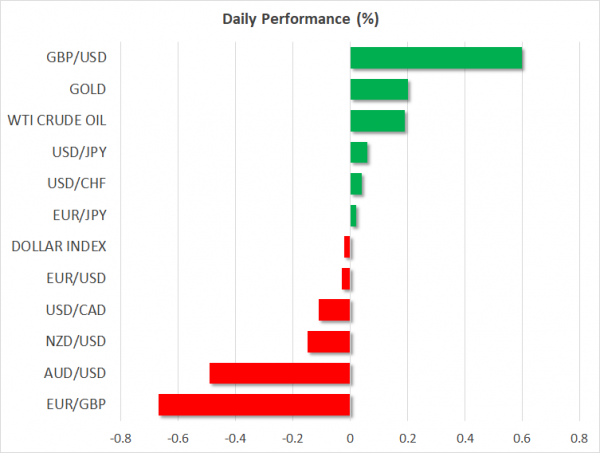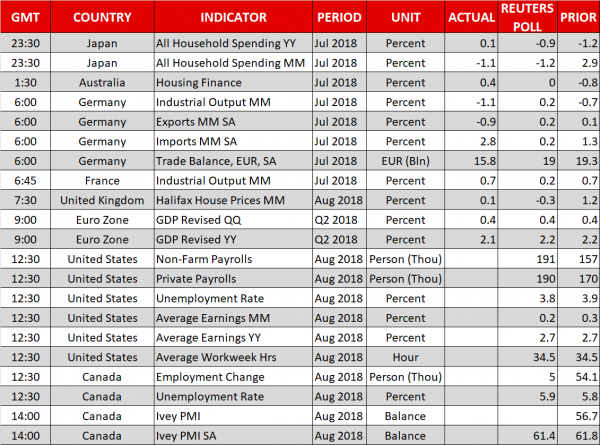Here are the latest developments in global markets:
- FOREX: The US currency was trading marginally lower versus a basket of currencies ahead of the highly anticipated employment report for August due at 1230 GMT. Dollar/yen was roughly flat after losing 0.7% on Thursday, as angst over the prospect of deteriorating global trade conditions boosted the safe-haven perceived yen. The euro was down on the margin versus the dollar, reacting little to a downward revision in the eurozone’s pace of growth in Q2 to 2.1% from 2.2%. Earlier in the day, the common currency fell in the immediate aftermath of German data which showed exports and industrial output unexpectedly contracting in July, though it reversed higher soon thereafter. Pound/dollar jumped above 1.30, as a UK parliament transcript revealed that the EU’s chief Brexit negotiator Michel Barnier said that the bloc is willing to discuss the impasse relating to the Irish border; “we should be able to de-dramatize the Brexit backstop” were some of his words. Euro/pound lost ground as a result too. Elsewhere, the Aussie slipped to a fresh two-and-a-half year low of 0.7136 as growing worries over an escalation in the Sino-US trade dispute once again acted as a drag on the commodity-linked currency.
- STOCKS: Major European benchmarks were broadly lower at 1118 GMT, though barring a few exceptions the losses were relatively contained. Fears over global trade were again the major culprit behind the bearish equity market sentiment, with anxiety over EM-health (or lack of health) also contributing to that “cause”. The pan-European Stoxx 600 was down by 0.2%, trading not far above a five-month low of 372.20 tracked earlier on Friday. Meanwhile, the blue-chip Euro Stoxx 50 was lower by 0.4%. The German DAX and French CAC 40 fell by 0.3% and 0.15% respectively, while the UK’s FTSE 100 underperformed, trading lower by 0.9%. The latter was also dragged lower by the rise in sterling due to its export-heavy nature. Futures tracking the Dow, S&P 500 and Nasdaq 100 were pointing to a slightly lower open later today.
- COMMODITIES: WTI and Brent crude both edged higher by 0.2%, trading at $67.90 and $76.65 a barrel respectively. The expectation for a fresh round of tariffs, which may also dent demand for oil, has been weighing on oil prices throughout the week. In precious metals, dollar-denominated gold was 0.2% higher and not far above the $1,200 per ounce mark, possibly benefitting on the back of a slightly weaker greenback; the metal yet again failing to attract safe-haven flows on trade uncertainty is of note.
Day ahead: US payrolls report takes center stage as markets await trade news
The main event in Friday’s session will be the US employment report for August at 1230 GMT, with the corresponding data out of Canada also on tap. Beyond economic releases, investors will remain mindful of trade developments, as the US gears up to launch a fresh salvo of tariffs on $200bn Chinese products.
Kicking off with the US data, nonfarm payrolls (NFP) are projected to have risen by 191k in August, more than July’s 157k and overall a strong print consistent with further tightening in the labor market. Meanwhile, the unemployment rate is forecast to have ticked back down to a near two-decade low of 3.8%, from 3.9% previously. Last but not least, average hourly earnings are anticipated to have grown by 0.2% in monthly terms, which would keep the yearly rate steady at 2.7%. Absent a major surprise in the NFP print or the unemployment rate, investors may focus mainly on earnings, as wage growth is considered a precursor to inflationary pressures and hence plays a major role in guiding Fed decisions.
While market-implied pricing derived from Fed funds futures suggests a Fed rate hike in September is a done deal, investors appear less certain on whether a second one will materialize before year-end, assigning a 63% probability to the prospect. A strong report today that pushes those odds higher could help the dollar recoup its latest losses. On the contrary, any softness in the data that drags that probability lower towards a “coin toss”, may weigh on the greenback.
Turning to Canada’s jobs figures, forecasts suggest the labor market cooled in August, with the unemployment rate expected to tick up to 5.9%, from 5.8% in the prior month. The uptick appears owed to expectations for nearly-flat jobs growth, with the net change in employment projected to clock in at 5.0k, much lower than the 54.1k in July. The US and Canadian reports are released simultaneously, so the reaction in dollar/loonie will likely be influenced by both. Besides these data, US-Canada trade negotiations continue in Washington today, and the loonie will likely remain sensitive to any updates.
On the trade front, the Trump administration has signaled it plans to slap tariffs on $200bn Chinese products, with a potential announcement coming as early as today. China has warned it will retaliate in kind and thus, a further deterioration in risk sentiment is not to be ruled out. In such a case, funds may rotate out of riskier assets like stocks, and into safe-havens such as the Japanese yen and Swiss franc.
In energy markets, the Baker Hughes survey tracking active US oil rigs is due at 1700 GMT.
As for the speakers, regional Fed presidents Rosengren (non-voting FOMC member in 2018), Mester (voter), and Kaplan (non-voter) will be making public appearances at 1230 GMT, 1300 GMT and 1720 GMT respectively. Then, RBNZ Governor Adrian Orr will speak at 2130 GMT.
In politics, French President Macron will meet his German counterpart, Chancellor Merkel, to discuss Brexit among other issues.
Over the weekend, Sweden will hold its general election, with krona pairs likely to open with gaps on Monday.














